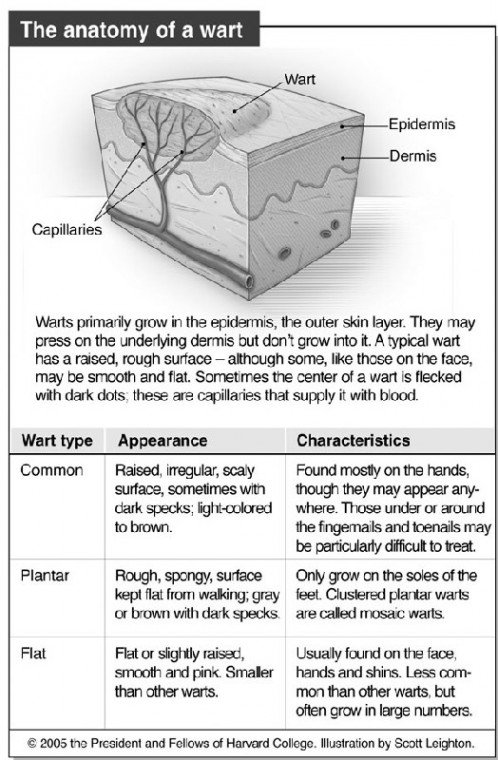Q: Despite being wart-free since early childhood, I recently
started noticing new warts on my hands. What causes them, and what
is the best way to get rid of them?
Q: Despite being wart-free since early childhood, I recently started noticing new warts on my hands. What causes them, and what is the best way to get rid of them?
A: Warts are made up of skin cells that multiply faster than normal because of a specific virus, the human papillomavirus (HPV), forming a lump on the surface of the skin. HPV is actually a family of some 80 strains, and different strains cause different kinds of warts. The most common strains give rise to cutaneous (skin) warts. The wart virus lives in the upper layers of the skin and can live there for years without causing warts. Then one day the virus creates a wart for reasons that are not yet understood.
The virus that causes skin warts is everywhere and easy to encounter, but it isn’t very contagious. It can spread from person to person by direct contact, but usually only through breaks in the skin.
Theoretically, susceptible people can pick up warts from surfaces such as locker room floors and showers. If you have warts, you can spread them to other areas on your body, so it’s important to wash your hands and objects that touch your warts, such as nail files or pumice stones.
There’s a 50 to 60 percent chance your own immune system will get rid of the wart within two years. Doing nothing is the best way to go if you find the treatments even less appealing than the wart itself. Therapies such as liquid nitrogen and cutting can be painful and leave scars; others may simply be inconvenient.
If you’d prefer not to wait out your warts, there are several strategies you can try. We’ve listed some options below:
SALICYLIC ACID
Salicylic acid, the main ingredient in aspirin, is available over the counter as a liquid, gel or patch. You first soften up your wart by filing away dead, warty skin with an emery board or pumice stone.
Then you soak the wart for 10-15 minutes and apply the salicylic acid. Do this once to twice a day for 12 weeks. Warts in thick skin, such as the soles of the feet, may respond best to patch application (a patch stays in place several days at a time). Continuing treatment for a week or two after the wart goes away may reduce recurrence.
DUCT TAPE
Yes, it’s true. Duct tape works. One study found that using duct tape was about 45 percent more effective than freezing warts with liquid nitrogen. Subjects wore duct tape patches matching the size of their warts for six days.
Then they removed the patches, soaked and filed the warts, left them uncovered overnight and reapplied tape patches the next morning. They followed this regimen for two months or until the wart disappeared.
You can also place a piece of duct tape over the wart after you apply salicylic acid. Why duct tape works is not clear, but it may deprive the wart of oxygen.
In addition, removing the tape takes away dead skin and viral particles. There’s also speculation that duct tape irritates the wart, thereby activating the immune system.
FREEZING
Liquid nitrogen (cryotherapy) is effective, but can be painful. A clinician sprays or swabs it onto the wart and a small surrounding area. The extreme cold (minus 324 F) burns, causing redness and usually a blister. Getting rid of the wart generally takes at least three or four treatments, one every two to three weeks. Using salicylic acid after the skin has healed helps encourage more skin to peel off.
ZAPPING AND CUTTING
A clinician using local anesthesia performs Electrodessication and curettage. She or he dries the area with an electric needle and scrapes away the wart. This procedure – also used to remove skin cancers – usually causes scarring.
So does removing the wart with a scalpel, another option. Cutting has a lower cure rate than either salicylic acid or liquid nitrogen. Duct tape hasn’t been studied long enough to know how it stacks up against these and other therapies.
OTHER AGENTS
Warts that don’t respond to standard therapies can be treated with prescription drugs (some given as injections in a physician’s office). These tend to have more side effects.
If your wart is not responding to home-based treatment, remember that it’s possible that what you think is a wart is actually something else. Some skin cancers initially resemble warts. If you have a wart that stays the same size and doesn’t change much, you probably don’t need to have a clinician check it out.
But if you’re in your 50s and develop warts, consult a dermatologist. Be suspicious of any wart that bleeds or grows quickly; it may not be a wart, but a small skin cancer.
Submit questions to the Harvard Medical School Adviser at www.health.harvard.edu/adviser. Unfortunately, personal responses are not possible.












